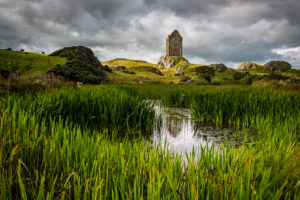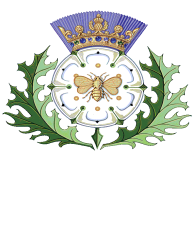by John Sadler
 One of the most notable historians of Anglo-Scottish Border conflicts, John Sadler has published a number of books on the subject and is also a successful lecturer, heritage consultant, historical interpreter and battlefield tour guide. ‘From an early age I have been obsessed with the highlands and borders.’ he says, ‘Since then I have travelled, walked, ridden and driven over most of the ground and looked at every battlefield, hillfort, broch, dun and castle.’
One of the most notable historians of Anglo-Scottish Border conflicts, John Sadler has published a number of books on the subject and is also a successful lecturer, heritage consultant, historical interpreter and battlefield tour guide. ‘From an early age I have been obsessed with the highlands and borders.’ he says, ‘Since then I have travelled, walked, ridden and driven over most of the ground and looked at every battlefield, hillfort, broch, dun and castle.’
Sadler regularly lectures at The National Army Museum, Imperial war Museum, RMA Sandhurst, Heriot Watt University, Society of Antiquaries of Newcastle upon Tyne, The Literary and Philosophical Society, Newcastle, Durham University, the DLI Museum & Art Gallery and contributes to many military and historical journals as well. He is a Fellow of the Royal Historical Society, a Fellow of Scotland’s Society of Antiquaries, a graduate Holocaust Fellow of the Imperial War Museum and a member of Equity.
STEEL BONNETS
Episode 3
Wardens of the Marches
When we speak of the Border we are referring to a remote part of England, far away from the centre of power, difficult and expensive to police. A fairly complex means of trying to keep order was established as early as 1249, when the Scottish and English governments agreed that the border should be divided into six Marches – three on each side: East, Middle and West. From 1297 these Marches were controlled judicially and militarily by March Wardens. These officers were usually appointed from the south of the country, in order to avoid the obvious possibility of bias for or against the feuding names over which they were intended to hold sway. The examples of Percy and Neville in the fifteenth century evidenced the risks attached to conferring such vice-regal powers on unruly local magnates.

It was the Wardens’ tricky duty to see that peace was maintained, to administer justice and to deal with ‘bills’ or complaints. Backed up by a staff of deputies, captains and troopers, they tried with varying degrees of success to administer good law, but in doing so would frequently create personal enemies (some were murdered) and further bitterness between already bellicose riding names. In short, they frequently caused more problems than they solved and most certainly did not implement peace and safety for the marchers. One such Warden was the notorious Sir John Forster, not from the south, we’re proud to say but a native Northumbrian:
A regular subject of Border correspondence, he was the target of frequent accusations ranging from collusion with the Scots and neglect of duty, to using his office as a cloak for thieving and skulduggery, his accusers further adding that Sir John’s catalogue of shortcomings ‘would fill a large book’. Most of this was in fact true and his protestations of innocence are somewhat less than convincing.
Sir John was a truly Falstaffian character whom I’ve played on a number of occasions.
I do sincerely hope the old rogue would be flattered by these portrayals. To be fair I’ve offered him as bellicose, addicted to strong drink, a wager or two and loose women, untrammelled by any conflict twixt duty and reward. These are characteristics I admire though, of course, in a puritanical age blighted by the sterile Stalinism of PC orthodoxy I’d be wary of making any such admission.
After a raid, with the lifting of cattle and possibly taking of lives, the thieves would naturally set off for the relative safety of tower or sheltering moss without delay. Above all else, success would lie in the speed with which sortie and getaway were accomplished. Escaping reivers would be much hampered by the four legged spoils – cattle are notoriously difficult to move at speed – and it was essential to be familiar with every step and inch of the landscape so that temporary lying up places and strategic sites for ambush were known and used with facility.
He who was left victim of such a raid had three choices: to make complaint to the Warden, to bide his time until he could wreak revenge (with interest if possible), or to mount a hot trod. If some time elapsed before the pursuers set out it was known as a cold trod. Either way, the legality of the trod depended on its being within six days of the raid, and as MacDonald Fraser points out, a careful line was drawn, under Border law, between a trod and reprisal raid. If the trod was cross-Border, it was essential to make it clear that legal pursuit was underway: a lighted turf was to be clearly visible on the pursuer’s lance point, an earnest of open and peaceful intentions. He had a legal right to assistance from marchers across the Border, and trying to hinder the trod was a punishable offence, one far more honoured in the breach than the observance.
 The trod could easily become a bloody affair; however strict the supposed rules, the business might frequently ended in a fierce skirmish during which fighters from either side stood to lose life or limb; the law was not likely to call a trod-follower to account if his rage got the better of him and he dispatched a reiver out of hand.
The trod could easily become a bloody affair; however strict the supposed rules, the business might frequently ended in a fierce skirmish during which fighters from either side stood to lose life or limb; the law was not likely to call a trod-follower to account if his rage got the better of him and he dispatched a reiver out of hand.
A reiver looked nothing like a traditional knight in plate harness. As a specialist he needed the right gear to support such a dangerous business. First, and most importantly perhaps, he required a horse. Remembering that the Borderers could be called up to fight for king and country (never with any marked enthusiasm), horses needed to be suitable mounts both for light cavalry work in time of war, and for raiding in time of ostensible peace. Known as hobblers, hobilars or garons, they were sturdy and fast, and like Cumbria’s hardy Herdwick sheep they were cheap to keep. There is evidence that they weren’t groomed and didn’t have need of shoes. They were said to be capable of transporting a man from Tynedale to Teviotdale and back in 24 hours.
Given the need (above all) for speed and ease of manoeuvre, the reiver rarely wore expensive armour even if he could afford it, which in most cases he could not. The preferred means of protecting the body was the ‘jack’ or ‘jacke’ which was widely used until the end of the 16 th Century.
To protect arms and upper legs many dalesmen would sew on pewter or brass chains, wrapped around four or five times; their lower legs protected by long, leather riding boots not unlike modern ‘biker’ boots. Body armour might consist of plate ‘breast and back’ but more likely just a padded jack.
Accoutred in this manner, they were able to combine mobility with an element of protection.
On his head, the reiver would wear a form of helmet called a burgonet, in use from the middle of the 16 th Century. This burgonet or steill bonnett was a rather more stylish helmet [than the earlier salade hat] which, in its lightest form was open and peaked. These offered good protection, having cheek plates and a flared rim at the neck as well as a peak at the front. In time (from about 1580) these were in turn largely superseded by the morion or pikeman’s pot.
 Borderers carried a variety of weapons. As George MacDonald Fraser points out, the 16 th Century was the bridge between the medieval knights and men-at-arms, with their heavy armour and weapons, and the age of firepower. Most would sport a lance, used for thrusting and throwing at the enemy – and for fishing, too! There is a record of riders spearing salmon from horseback in the Solway Firth, testimony to their extraordinary skill with this difficult weapon.
Borderers carried a variety of weapons. As George MacDonald Fraser points out, the 16 th Century was the bridge between the medieval knights and men-at-arms, with their heavy armour and weapons, and the age of firepower. Most would sport a lance, used for thrusting and throwing at the enemy – and for fishing, too! There is a record of riders spearing salmon from horseback in the Solway Firth, testimony to their extraordinary skill with this difficult weapon.
Equally as ferocious was the ‘Jeddart Staff’, made or said to have originated in Jedburgh; this was a slim 1.25m (4ft) blade set into a wooden staff, the blade having a cutting edge and a fearsomely dangerous spike. Another favourite weapon was the bill, which had a spike, a hook and a single heavy cutting edge. Both at war and on a raid, the reivers would use also a backsword, a dagger and possibly a brace of handguns, although the guns of the time were inaccurate at a distance and useless at close quarters. As a true anorak, I’m in thrall to edged weapons, frightful admission of course and I’ve promised to get counselling, but they are fine, a blend of art and deadly purpose, provided you’re not on the receiving end of course.
It was the unenviable task of the Border Wardens to seek to maintain law and order whilst also acting as local generals in time of war. A corpus of unique border laws, Leges Marchiarum, was drafted to cope with the vibrant brand of lawlessness that prevailed. In many instances these
officials, like Sir John Forster, who clung to his office until well into his nineties, were more of a symptom than a cure. Sir John was a leading shareholder in most disreputable ventures within his march and was far from being an exception!
This situation was exacerbated by the pernicious code of the vendetta, a relentless legacy of murder known as the ‘feid’ (feud). The inhabitants of southern Europe would have nothing to teach our borderers when it came to seeking revenge. Vendettas are obviously popular with re-enactors; after all they’re usually at feud with each-other anyway and the chance for a melee is never one to be missed. It’s fair to say no script ever survives contact with actual performance but a vendetta doesn’t need careful scripting – kill them all does nicely!
From Carter Bar, the high watershed that divides the two kingdoms, the view stretches northward over the rolling crests of Philip Law, Woden Law and Whitestone Hill, a sea of harsh grass and heather, plucked and furred by the winds in winter, a carpet of green in spring and summer.
Secretive still and unspoilt, the border country offers the visitor unique insight into a troubled past.
Though the plough has tamed those fearsome marshes or mosses where reivers skulked and man-made forests have replaced that dense canopy of old, wild wood, it is still possible for us to glean an impression. This area has been militarised since the days of the Roman occupation – Sewingshields on Hadrian’s Wall also has Arthurian connections. At least one contemporary author asserts that the Arthurian legends are firmly rooted in the later Roman era along the northern frontier with Roxburgh as the ‘real’ Camelot.
Ironically, these hills still reverberate to sounds of war as the Ministry of Defence continues to utilise the Otterburn and Redesdale training areas. This is a very expensive form of enactment, vast treasure was disbursed to widen the A696 so it could accommodate a monstrous new generation of self-propelled guns, steel leviathans that could wreak destruction on a scale of reiver ancestors could not even begin to comprehend; just as well they weren’t around at the time.
Having sampled the unique splendour of the Wall the visitor could detour, initially via the A68, heading north to West Woodburn before branching left toward Bellingham, the market town of the North Tyne. From Bellingham head westwards to Kielder, a great man-made waterway, and follow the valley toward the border line at Riccarton. You are now in Liddesdale, (though the inhabitants are a good deal friendier these days).


 + 1 917 512 2948
+ 1 917 512 2948